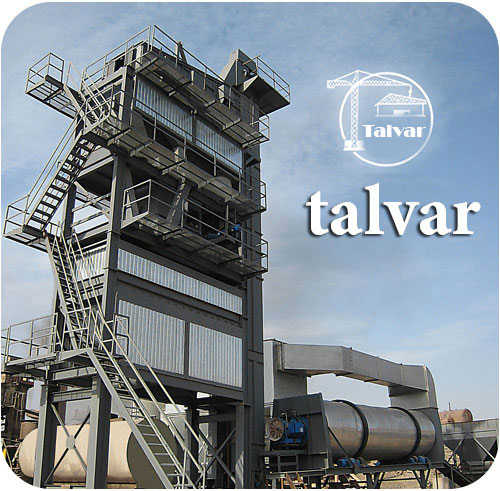
Asphalt is the combination of sand with coating materials and binders (tar) and the stone dust filler which is mixed by special machinery and with specific proportion. Asphalt is categorized into two types of cold and hot asphalt. In the production of cold asphalt, sand and gravel are mixed with tar without heating and then are loaded for use.
Hot asphalt plants are designed and constructed in two types.
1. Continuous Type (asphalt drum mix plant).
This type of asphalt plant is designed in a horizontal manner and hot asphalt is produced in a linear and continuous way. Controlling of materials in continuous asphalt plant is done volumetrically.
The continuous asphalt plant does not need to utilize a twin shift mixer, bins and the whole asphalt tower, thanks to adjustments made to its dryer. In this design, the mixture is done in the ending part of the dryer and complete asphalt is prepared for loading from the end of drum mixer by a conveyor belt.
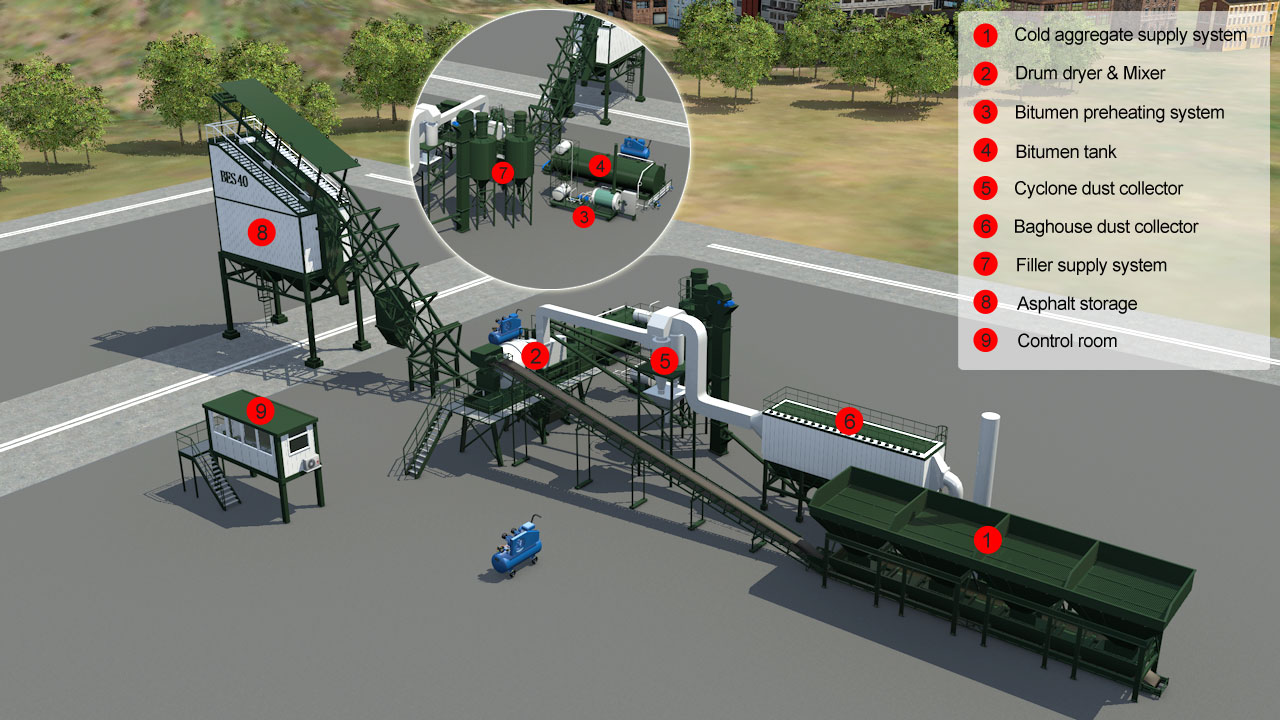
2. Batch Type Asphalt Plant.
In this kind of plant, after sand is heated in the hot aggregate elevator, it is sent to the asphalt batch (tower) where the material is screened, weighed and mixed.
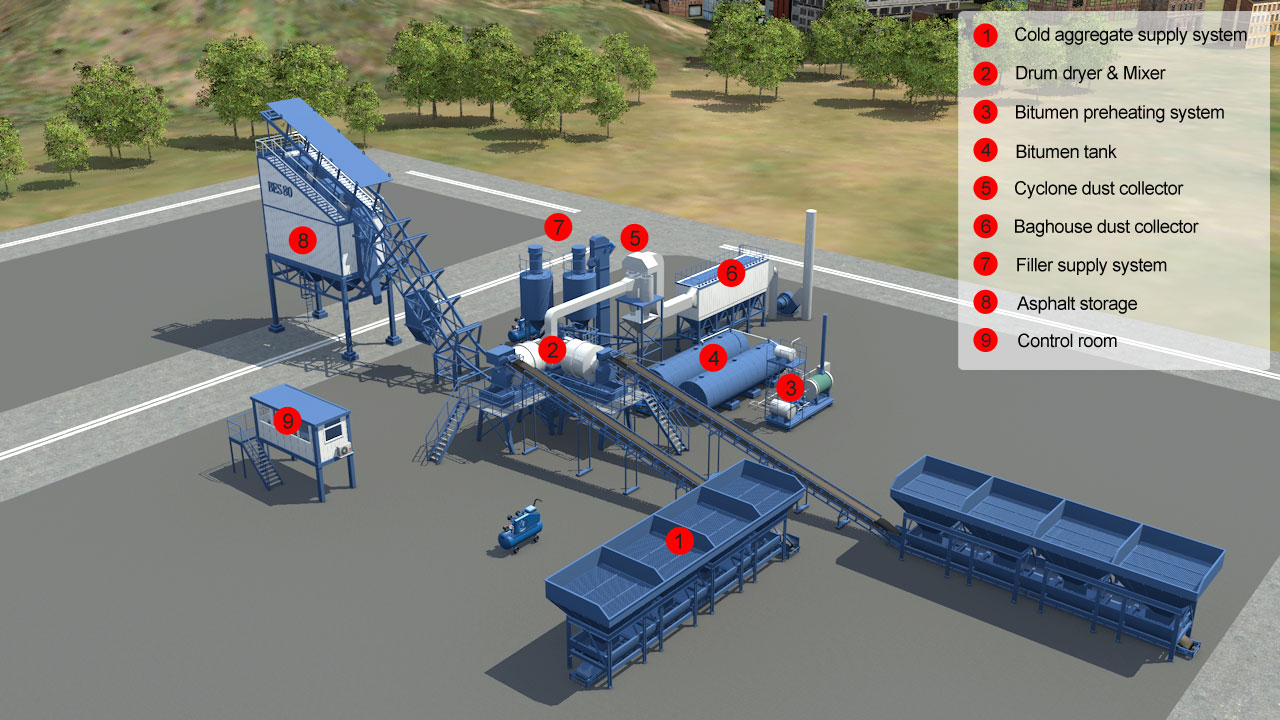
Talvar Asphalt Production Plants are constructed based on authentic standards and by resistant steel and highly firm structures.
All mechanical components are designed and produced based on the latest technologies by the company’s experts. The functionality, new technology, and high confidence coefficient of the design of the components have created considerable attraction among clients. It is noteworthy that the company provides all parts for a lot of years after their sale to the clients.
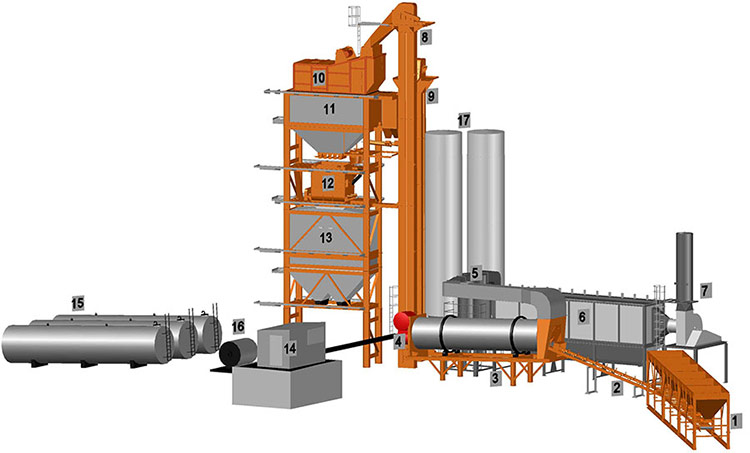
We will satisfy your needs of constructing roads by providing various types of asphalt plants and rock crushing plants with diverse capacities.
An asphalt plant comprises bellow sections:
1. Cold Aggregate Feeder: Feeder or cold aggregate hopper in an asphalt plant is the first machine in which material is stored and then gradually and in controllable volumes is sent to the dryer by a conveyor belt. Cold aggregate feeder in asphalt plants usually have bins (hoppers) which are used for feeding and storage of 4 kinds of material but this number can increase depending on clients’ grading needs.
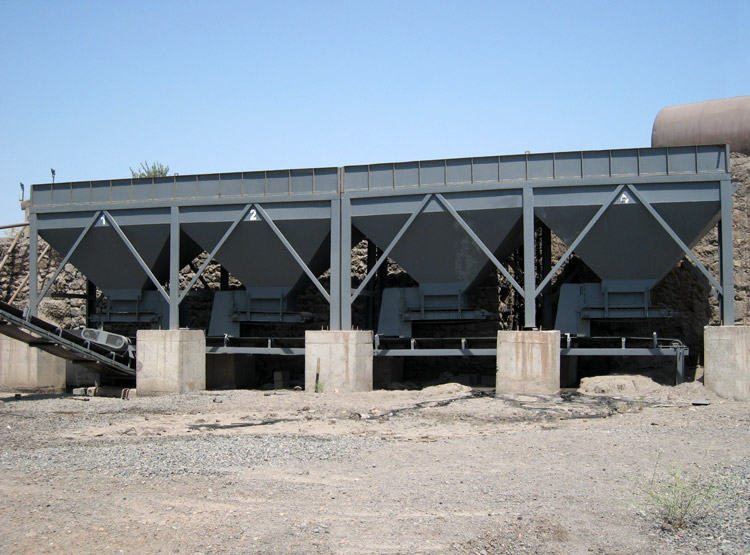
2. Conveyor Belt: It is located next to the feeder to transfer the materials to the dryer. 3. Dryer: The most important part of a hot asphalt plant is the dryer which is responsible for heating up the sand apart from drying it.
3. Dryer: The most important part of a hot asphalt plant is the dryer which is responsible for heating up the sand apart from drying it.
* In batch plants or batch towers, the dryer is only responsible for heating. However, in continuous types, apart from heating, it mixes the materials and by adding tar and filler, it gives out ready-to-use asphalt.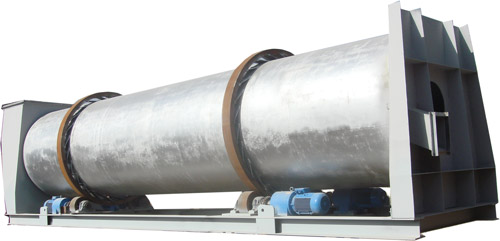
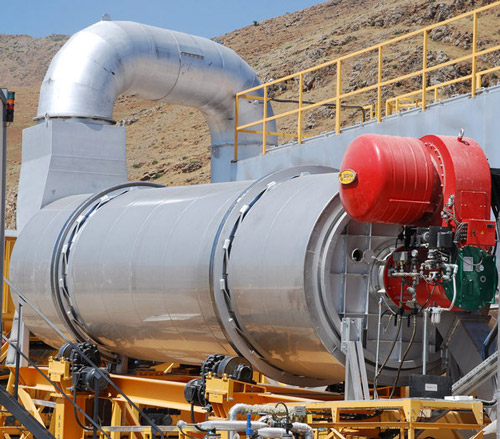 4. The Dryer Turbojet Burner: Burners manufactured at this company are the replica designs of the German Siemens turbojets which are equipped with invertors and are controllable from the control room in order to regulate the exact amount of oxygen and fuel. The burners can be designed and manufactured in two types between 2 to 16 million calories per hour depending on the need of the asphalt distributing factories and other industries. This burner has the ability to adjust the ratio of oxygen and fuel automatically and can use mazut, gas oil and natural gas to reach its maximum heating capacity. The burner can be manufactured in two bi-fuel and tri-fuel types.
4. The Dryer Turbojet Burner: Burners manufactured at this company are the replica designs of the German Siemens turbojets which are equipped with invertors and are controllable from the control room in order to regulate the exact amount of oxygen and fuel. The burners can be designed and manufactured in two types between 2 to 16 million calories per hour depending on the need of the asphalt distributing factories and other industries. This burner has the ability to adjust the ratio of oxygen and fuel automatically and can use mazut, gas oil and natural gas to reach its maximum heating capacity. The burner can be manufactured in two bi-fuel and tri-fuel types.
Bi-fuel Burner (gas oil and mazut): The flame shield for this burner is made of refractory sheet and can resist up to 1500 degrees.
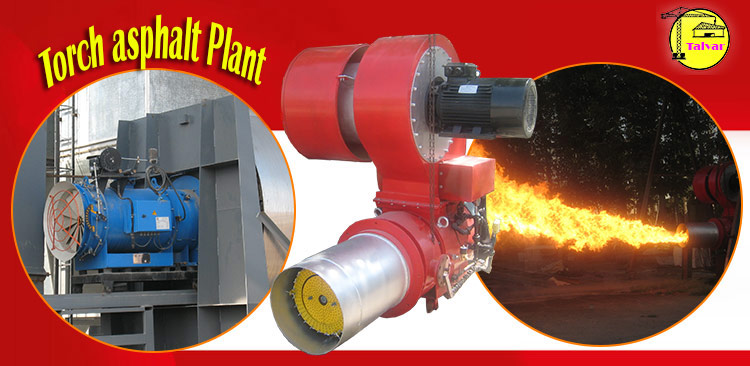

5. Multi-cyclone Filter: The air that has been sucked by the fan is initially blown to the multi-cyclone unit so that the coarse dust in the air can be filtered by utilization of eccentricity and a kind of special mass. The dust is then stored at the bottom of the filter to be used as filler later on.
6. Bag Filter: Bag filter is a device to collect the dust which has been created in a process. This device is composed of a clean air case, filtration chamber, filter bag, compressed air tank, diaphragm valves and evacuation system.
A bag filter is designed and calculated based on pollutant type, size of dust particles and the required debit. The calculations consist of parameters such as filtration level, particle absorption speed, and finally suction power provided by the centrifuge fan.
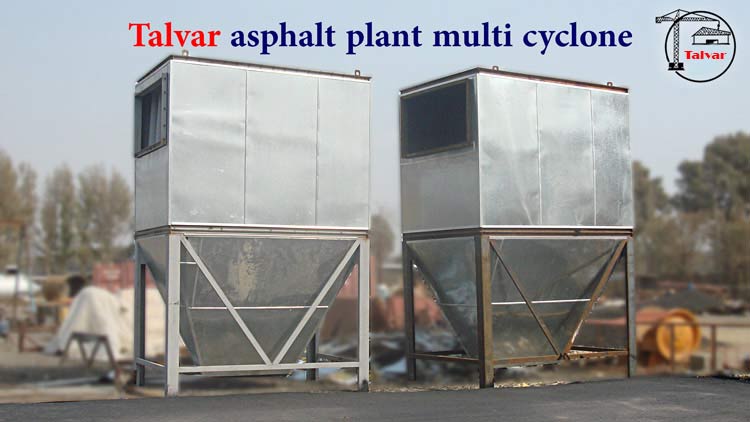
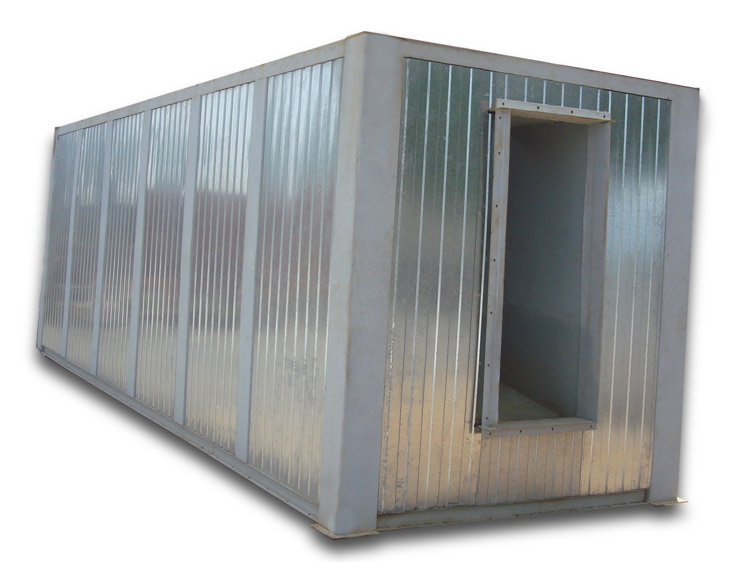
7. Exhaust Fan (Air Drawing Fan): Asphalt plant exhaust systems are designed and made according to asphalt plant features and needs with various capacities. The system is administered from the control room and automatically controls the air flow caused by the ignition.
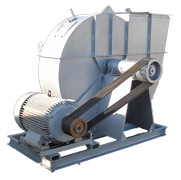
8. Elevator: In order to transfer the hot sands discharging from the dryer to the top of the asphalt batch, a bucket elevator conveyor belt is used. Also, the filler provided by multi-cyclone and the bag filter use elevator chain or bucket elevator conveyor belt.
9. Scurvy Filler: One of the most important components of asphalt is filler. Filler is a combination of the particles from the asphalt material which have been filtered from the gases caused by the ignition in multi-cyclone system and bag filter and then added to asphalt production system.
It is noteworthy that to optimize consumable filler, compensate its shortage and modify its grading, other consumable materials such as cement, hydrated lime and stone powder can be used.
10. Vibrating Screen: In order to separate and grade the materials in asphalt batch, screen is used. This screen, typically, has three levels and can separate sand in 4 sizes through a vibration system. In case more exact grading of the materials is needed, more stories can be used in the screen.
11. Hot material Silo (Hot Silage): Just below the screening unit in the batch tower, there are hot material silos as many as the number of required grades. These are used to store hot sand. Below these silos, there are controllable hatches for exiting hot materials.
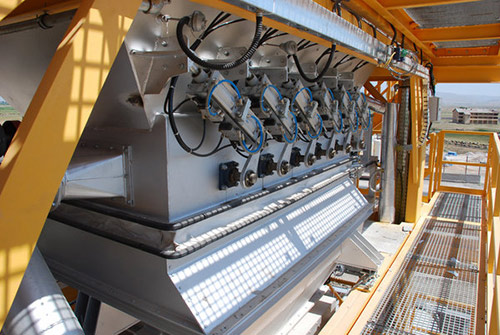 12. Asphalt Mixer: The mixer is located at the bottom of the batch tower to combine sand and filler according to the asphalt plan and the produced asphalt is ready to be discharged to storage silo or the truck.
12. Asphalt Mixer: The mixer is located at the bottom of the batch tower to combine sand and filler according to the asphalt plan and the produced asphalt is ready to be discharged to storage silo or the truck.
13. Tar (binder) Scale: The amount of tar plays an important role in the combination of the produced asphalt; therefore, it is precisely weighed by a digital scaling system. This system consists of digital markers and related load cells.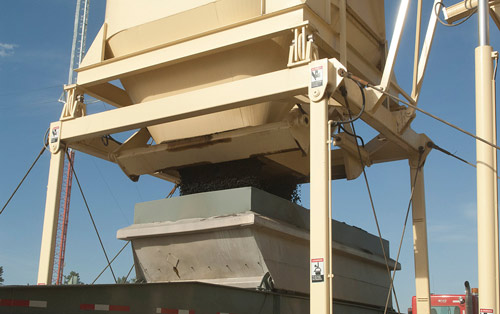
14. Control Room: Control room is considered as one of main parts of asphalt plants and is equipped with a set of precise control instrumentations along with power control equipment in two separate cells (Power and Control). Correspondingly, in order to prevent the transmissions of vibrations caused by working production line machinery and to increase operator's vision, the control room is installed and run dependently and away from the asphalt plant tower. Benefiting from modern technology and by controlling numerous input and output units, the control room administers production processes. The electronic scaling system employed is equipped with digital markers and has the ability to set different weighs. Additionally, there are other abilities such as reporting the amount of materials, tar and consumable fillers in various time periods such as batch, hour, day, week, month, and year and can be printed if connected to a printing machine. The digital marker can be set on three modes; manual, semi-automatic and automatic. When put on the automatic mode, the asphalt plant operator only observes the visual and audial functions of the production line.
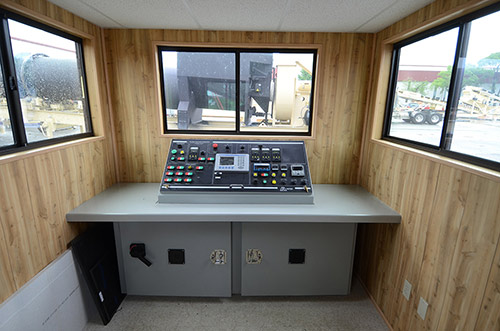
15. Tar Flask: To produce asphalt, the consumable tar must be heated up to 150 degrees. An oil heater system and a tar flask storage are used in order to heat up the tar. The hot oil is sent to the tar flask coil and the heat caused by ignition in thermic oil is transferred to the tar, heating up the needed tar and preparing it for transfer to the system mixer.
In order to prevent wasting of heating energy and time and to store hot tar, the flasks are equipped with heat coil systems and glass wool or rock wool plus protective aluminum cover.
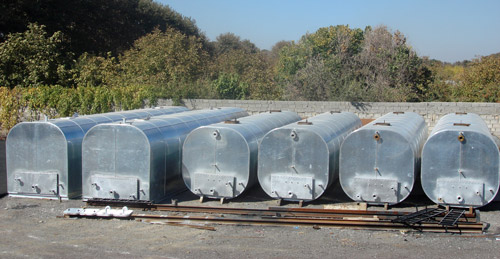
16. Oil Heater: Oil heater device is used in order to provide heating and transfer of the heat to make consumable tar hot. The temperature of the thermic oil is raised up to 150 to 200 degrees in the device and the tar is transferred to the tar flask. The tar is then pumped and circulated in the installed coil in the flask to be heated up to the desired degree.
In order to supply the oil heat in the coil of the oil heater and the related burner and to ease the transfer, the oil heater is designed and made in a way that all safety controls such as oil temperature and oil pressure of circulation pump are done and heating and transferring oil are provided automatically.
This machine transfers heat to the tar flask, double layer pipes and mazut flask in asphalt plant by circulation of hot oil. The machine is made in heat capacities of 250000 to 1200000 kilo calories and expansion tank capacities of 250 to 300 liters.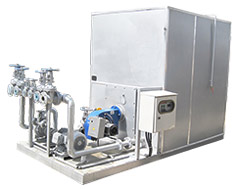
I. Fan (Blower): A fan (vacuum) is used in order to vacuum the dust and gases caused by the ignition inside the dryer, screen, mixer and all the parts in which materials and dust exist together.
III. Water Filter: The air which is blown from the multi-cyclone duster still has considerable amounts of smoke and soil particles. In order to separate them, a secondary filter which functions through a water method is used. The air passing through this filter is exposed to sprayed water drops and the smoke and dust particles are separated from the air.
IV. Water Source: When utilizing water filter in asphalt plants, in order to use the water efficiently and return the remaining water to the production cycle and also to make particles existing in the water subside, a pool or a pond is used. Then these ponds are deposed of sediments and are prepared to work again on a timely scheduled basis.
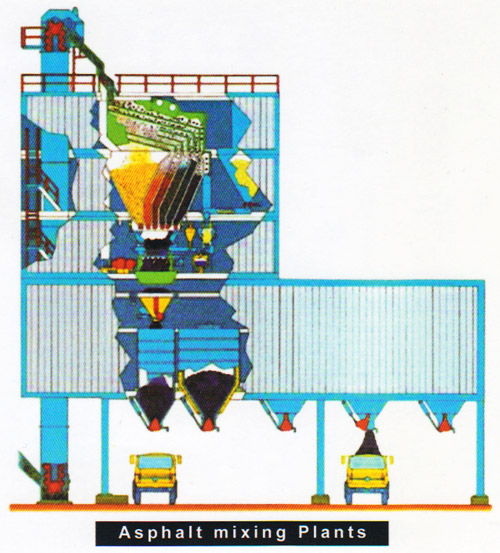
For more details refer to the section below or right click on the list asphalt plant.























